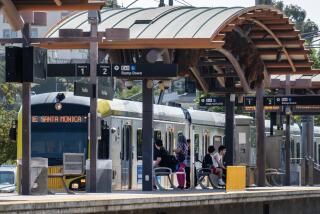Good News and Bad About Mass Transit
In Los Angeles County, it seems, the good news about mass transit is relative. For instance, the Santa Clarita Metrolink station ranks in the top five of the system’s 46 stations in terms of daily passengers. The grand total: about 330. Not bad, but not great either. Like the rest of the nine-county region served by Metrolink, fewer than four in 1,000 commuters use the train to get to work.
Even so, Santa Clarita is breaking ground on a third station--making it second only to Los Angeles in the number of stations it boasts. The hope is that as the Santa Clarita Valley grows over the next decade, ridership will increase. While the dream of getting more polluting commuters out of their cars is admirable, it will only come true if Southern California cities change the way they coddle the car.
Even with sluggish traffic it remains easier for most commuters to drive alone to work. There’s usually plenty of parking. They don’t have to ride a crowded bus or the subway to get to their offices from the train station. And even on the busiest days, the car always affords a private seat. Despite a burgeoning number of stations, more frequent trains and subsidized fares, it remains a challenge to lure drivers onto trains through incentives alone.
The Northridge earthquake demonstrated that motorists change their ways when commuting simply becomes too difficult. The collapse of the interchange between the Golden State and Antelope Valley freeways cut off the Santa Clarita and Antelope valleys from the rest of Los Angeles County. It took hours to drive just a few miles through the Newhall Pass. Consequently, Metrolink ridership skyrocketed as suburbanites trudged to work downtown. When the freeways got fixed, ridership dropped.
Improving the long-term ridership of big-ticket, high-profile transit systems like Metrolink or Metro Rail demands sticks as well as carrots. It must become harder to drive before the train becomes more attractive. How to do it? Many employers already charge employees to park and subsidize transit users. That’s a good step. But cities can also relax parking requirements for new projects. To encourage transit use, some cities such as San Francisco cap the number of parking spaces for traditionally traffic-heavy buildings like malls. That reduces costs and permits buildings in a more human scale and the kinds of streetscapes that encourage foot traffic near stations.
That may be revolutionary in a region like Southern California, where the personal car is almost a birthright. But current planning is contradictory. Even as mass transit is encouraged, everything from malls to office parks is built for cars. Getting people out of their cars and onto trains or buses means making the car a little more difficult and expensive to use. Probably not a happy to thought to some, but, like we said, the good news about mass transit is relative.
More to Read
Sign up for Essential California
The most important California stories and recommendations in your inbox every morning.
You may occasionally receive promotional content from the Los Angeles Times.









